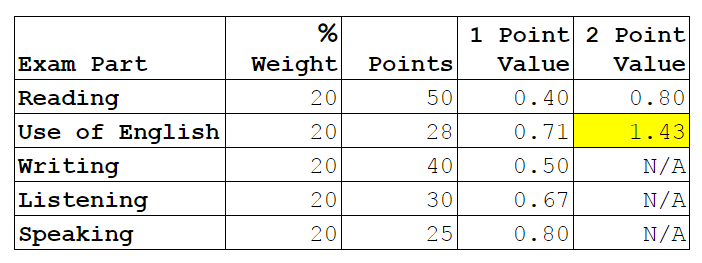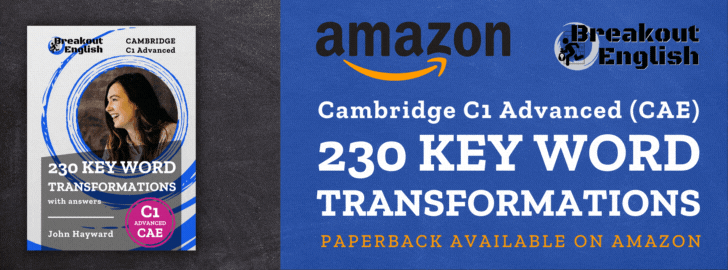Cambridge Advanced C1 key word transformations are arguably the most troublesome part of the exam. Even if you’ve been studying English for decades, you can come across some difficult questions in Advanced Use of English part 4. That’s because it’s not just about producing language at the level, it’s about producing exactly the language which Cambridge have decided to test for that question. While you may be a wiz at grammar and vocabulary exercise when you know what is being tested, with key word transformations, you have to first identify what type of grammar or vocabulary you need for each question.
The step-by-step process featured in this post is part of our premium materials: 230 C1 Key Word Transformations for the Cambridge Advanced exam. You can pick up a digital key word transformation exercises pdf or paperback copy on Amazon to put all these tips and tricks into practice.
GET 230 C1 ADVANCED (CAE) KEY WORD TRANSFORMATIONS

Contents
Why are C1 key word transformations so important for the exam?
Each question for this part of the exam is worth 2 points, which is double the value of the other Use of English parts. On top of that, because of the weighting of each section of the Cambridge C1 Advanced exam, each question in Use of English is worth a greater overall proportion of your final mark.
Don’t forget that of the Reading and Use of English paper, only parts 2, 3 and 4 are considered Use of English. Part 1, despite feeling like a Use of English activity, is counted towards your Reading result.
To understand the value of each question relative to your final weighted result, we’ve made this simple table. As you can see here, Each 2-point Use of English question (KWTs) is worth almost twice as much as questions in the Reading or Listening papers.

So what does this mean in practice? It means you should make sure you know what you’re doing for this part of the exam. Be extra careful with CAE transformations. One minor mistake with a preposition, article, plural, gerund or other detail can cost you a point. And you should always try to answer, even if you’re not sure, because you can get 1 point for a partially correct question.
How to do C1 key word transformations
If you’re taking the exam, you’ll need to know how to do key word transformations, and if you’re preparing students for the exam, you’ll need to know how to teach C1 key word transformations. Either way, there’s a step-by-step process, detailed below, that can help to ensure you are methodical in this part of the exam.
Work through the step-by-step process and then put it into practice with real exam tasks. Use official C1 Advanced materials or resources like Breakout English’s book of 230 C1 key word transformations.
Download the worksheet


Step-by-step process
Understanding the instructions
Every C1 key word transformations exercise includes exactly the same set of instructions. Look at the instructions and decide whether the following statements are true or false.
Complete the second sentence so that it has a similar meaning to the first sentence, using the word given. Do not change the word given. You must use between three and six words, including the word given.
- The 1st sentence and the 2nd sentence always use the same grammar.
- Your final answer will have the same meaning as the original sentence.
- The key word must be used in your answer.
- You can change the key word (e.g. to make it plural, to change the tense).
- An answer with five words is possible.
Answering the question
Step 1 – Identifying similar content
In order to identify what we need to transform, first we need to identify what content from the 1st sentence has already been included in the 2nd sentence.
Look at the sample question and underline or highlight the content in the 1st sentence that is already included in the 2nd sentence.

Step 2 – Identifying content to be transformed
Now we know what we don’t need to change, circle or highlight the content in the 1st sentence that we are going to be transforming with the key word.
These steps help us focus our attention and not spend too much time on each question. It is easy to have a mental block with C1 key word transformations, so let’s try to avoid that by concentrating only on the essential information.
Step 3 – Considering the language
Using the key word to help, think about the content that is missing and try to identify which language point or whether multiple language points are being tested. At C1 Advanced level, there is often more than one language point that is used to transform the sentences.
Look at this list of language points. Which one(s) are being tested in the example question?
- participle clauses
- fixed expressions
- past tenses
- cleft sentences
- linking words and phrases
- modal verbs
Step 4 – Answering the question
Now we are ready to answer the question. Complete the 2nd sentence with a similar meaning to the 1st sentence using between three and six words.
Step 5 – Checking your answer
Before we finish, it’s essential to check your answer and look carefully at the details. It’s easy to make a simple mistake and lose a point or two when it could have been avoided easily.
Use this checklist to check your answer to the example question.
- The number of words is correct (between 3 and 6).
- The key word has been used in its original form.
- The meaning of the 2nd sentence is sufficiently similar to the 1st.
- The tenses in the 2nd sentence correspond to the 1st.
- The subjects in the 2nd sentence correspond to the 1st.
- Any pluralisation of nouns is correct.
- Any necessary prepositions have been included and used accurately.
- Any necessary determiners have been included and used accurately.
- Any verb patterns have been constructed correctly.
- Spelling is correct.
Use this checklist with every C1 key word transformations question you complete. It may seem like a lot at first, but with time, it will become second nature.
Answers
Understanding the instructions
1 F 2 T 3 T 4 F 5 T
Answering the question
Step 1 – Identifying similar content

Step 2 – Identifying content to be transformed

Step 3 – Considering the language

Step 4 – Answering the question


